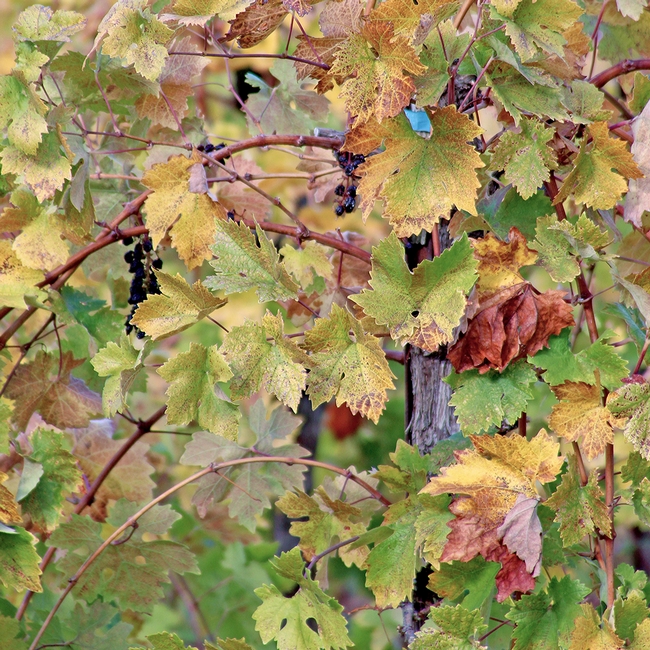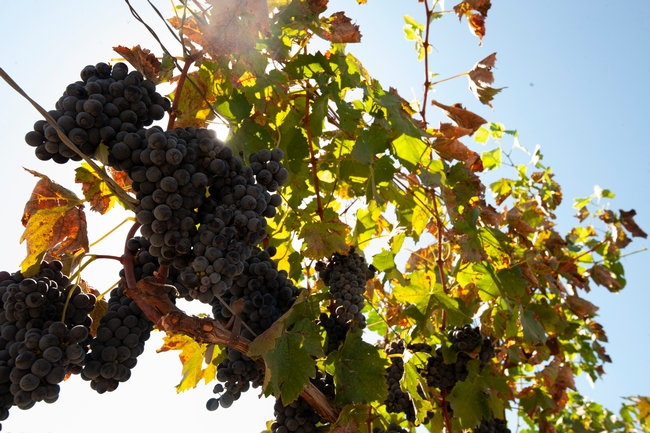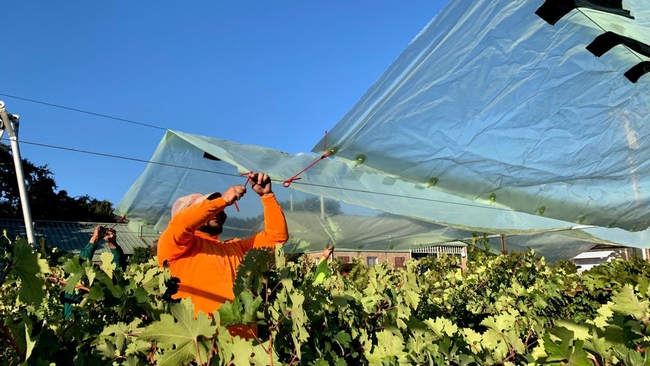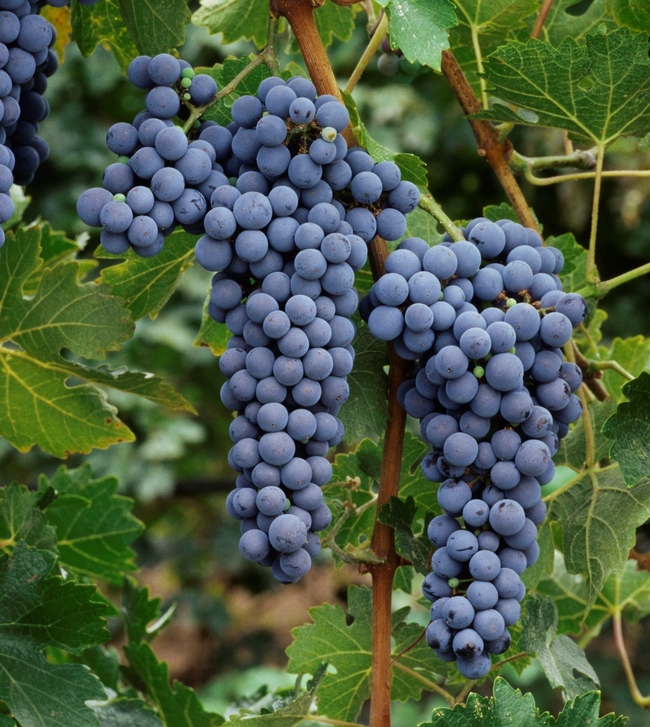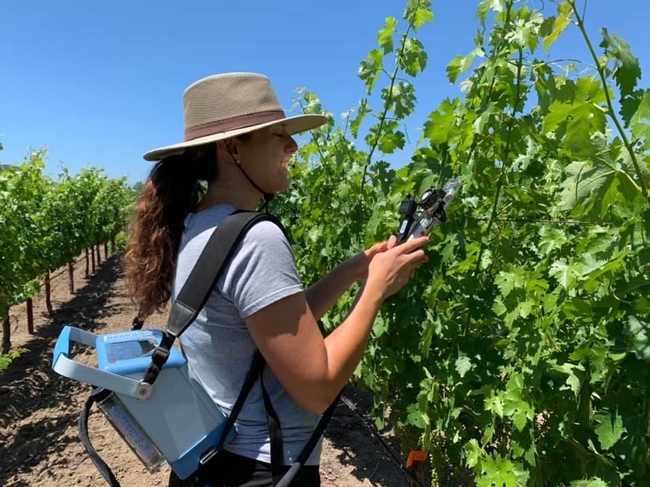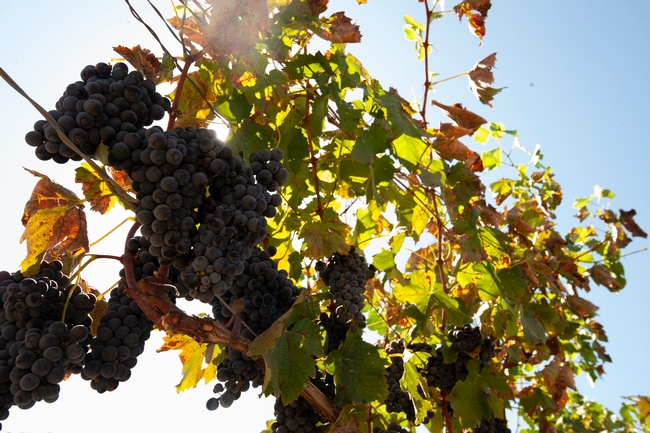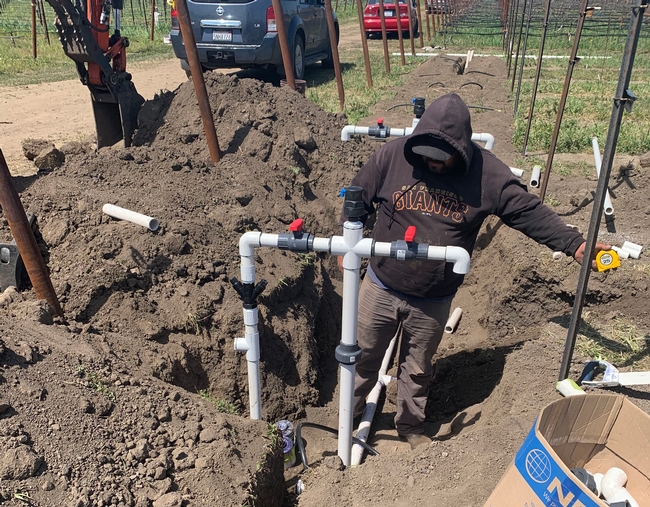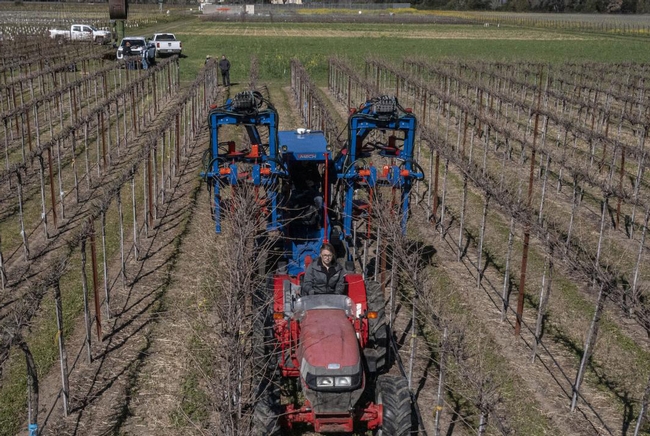Posts Tagged: Grapes
Grape experts give workshops on drought preparedness, red blotch
Grape growers and other industry members interested in grape production and water management in vineyards are invited to UC Cooperative Extension's Grapevine Drought Preparedness Workshops.
The workshops will be held in person on Friday, March 4, in San Luis Obispo and Friday, April 1, in Hopland.
Registration is $50 and includes a full day of live instruction from UC Cooperative Extension viticulture and grapevine experts. Lunch will be provided.
For more information and to register, visit https://ucanr.edu/sites/ShortCourse17.
UC Davis Grapevine Red Blotch Disease Symposium
On Wednesday, March 16, UC Cooperative Extension and the UC Davis Department of Viticulture and Enology will host a Grapevine Red Blotch Disease Symposium 9 a.m.-3:30 p.m.
Red blotch disease in grapevines, which can dramatically reduce the value of winegrapes, harms plants by inhibiting photosynthesis in the leaves. Infected vines are unable to conduct water effectively, leaving sugar that is created by photosynthesis stuck in the leaves instead of in the berries.
This event will be presented both in person at the UC Davis Conference Center and livestreamed for those unable to attend in person.
Presentations will cover the role of treehoppers, treatments, mitigation strategies, the impact of the disease on the composition of wine, and more.
Registration is $250 for the in-person symposium at UC Davis and $150 for the livestream. An application for 3.5 CCE units has been submitted to California Department of Pesticide Regulation and is pending approval.
To see the agenda and to register, visit https://wineserver.ucdavis.edu/events/uc-davis-grapevine-red-blotch-disease-symposium.
Researchers pinpoint drought-resistant traits in grape rootstocks
Findings could help wine industry adapt to climate change
Scientists at UC Davis have identified new root traits that help grapevines resist drought. The findings, published in the journal Annals of Botany, could speed up the development of grape rootstocks that protect vines from dry conditions, helping the grape and wine industry adapt to climate change.
The research, led by Department of Viticulture and Enology Assistant Professor Megan Bartlett, comes as 80% of California is experiencing extreme drought.
Most grapevines are not rooted directly into the ground but are instead grafted onto a rootstock, which forms the underground part of the plant and supports growth above ground.
“Rootstocks are an important tool to manage water stress,” Bartlett said. “Our goal was to identify traits that make rootstocks drought tolerant, so that grape breeders can amplify these traits in new varieties.”
Root cell traits
The study focused on traits measuring drought responses in living root cells.
The research specifically identified capacitance – which measures how much roots shrink as they dehydrate – as an important trait for drought tolerance.
“The water that enters the roots has to cross through a band of living cells to reach the xylem – the network of pipes that carries water up to the leaves,” said Bartlett. Most research has focused on xylem traits, but the living cells are often the first to be damaged during drought.
Water stress can shrink, deform, or even kill the living cells, causing the roots to shrivel away from the soil and lose access to the remaining soil water. Vines are then unable to replace water lost to evaporation and are forced to close the stomata – the small pores on the leaves that take in carbon dioxide for photosynthesis – to prevent severe dehydration. But closing the stomata stops photosynthesis and starves the vine of the sugars it needs to grow and ripen fruit.
This study is the first to test whether traits measuring root shrinkage and cell collapse can capture differences in rootstock drought tolerance.
Cell traits and drought tolerance
The researchers grafted Chardonnay onto eight commercial rootstocks. Half of the vines experienced drought conditions and half were kept well-watered in a greenhouse experiment.
The study found the eight rootstocks were surprisingly diverse and varied widely in their traits. The rootstocks also appeared to acclimate to drought by changing their traits in that the droughted vines were less susceptible to shrinkage and cell collapse than the well-watered vines.
Among the traits, capacitance was especially important for drought tolerance. The rootstocks with a lower capacitance (less root shrinkage) were better able to maintain photosynthesis during drought than other rootstocks.
“This research gives us a new trait to target for breeding more drought tolerant rootstocks,” study co-author and Ph.D. student Gabriela Sinclair said.
The research was supported by the American Vineyard Foundation, UC Davis, and by donations to the department from the Rossi family. Researchers at the University of British Columbia and the USDA-ARS Crops Pathology and Genetics Research Unit also contributed to the study.
Increasing temperatures led to better-tasting wine grapes, but for how long?
Study shows sugar, color content should be watched
Warming temperatures over the past 60 years have led to increased wine quality, but a new study looking at sugar and color content in grapes indicates the industry may be facing trouble if trends continue, according to collaborative research out of the University of California, Davis, and University of Bordeaux.
“Quality has increased steadily up to now,” said lead author Kaan Kurtural, a professor of viticulture and enology and an extension specialist at UC Davis. “We just don't know the tipping point.”
Kurtural's research, published in the journal OENO One, focuses on two renowned wine regions — Napa Valley and Bordeaux, France.
Researchers looked at ripening, grape quality and temperature data over six decades in both regions and then confirmed the findings with a five-year trial in Napa. They also consulted wine ratings in publications like Wine Spectator to gauge consumer demand.
One key finding: As temperatures exceeded what was considered the optimal level for quality, the grapes produced better wines.
“Previous research had few field data, but a record of assumptions,” said Kurtural.
Other quality factors at play
Temperature is a factor, but the paper suggests that sugar and color content should not be discounted. The authors also identified a biomarker that affects taste, color and other factors that can be the bellwether for climate change in red-skinned wine grapes.
“Temperature is always there,” he said. “Temperature is not your bellwether.”
Higher temperatures can harm grape composition, including color, taste and aroma. Researchers examined pigment and sugar content of five California vintages of cabernet sauvignon, finding that as the grapes got sweeter the skin and color deteriorated.
The degradation of these quality-related compounds and the observed plateaus of wine quality ratings suggests there can be too much of a good thing.
Researchers have long theorized that increasing temperatures from climate change would lead to shifts in wine-growing regions, opening up some new areas for vineyards and making others unsustainable.
That shift could be a boon to some economies and devastating to others, something the industry should watch.
“Since the 1980s, grapes got riper and they were able to make better flavor and color compounds,” Kurtural said. “Are we going to lose this or adapt more?”
Gregory A. Gambetta with the University of Bordeaux is a corresponding author on the paper.
For more information:
- Kaan Kurtural, Viticulture and Enology, cell 707-200-5378, skkurtural@ucdavis.edu
- Amy Quinton, UC Davis News and Media Relations, cell 530-601-8077, amquinton@ucdavis.edu
- Emily C. Dooley, College of Agricultural and Environmental Sciences, cell 530-650-6807, ecdooley@ucdavis.edu
Coastal grape growers can use less water during drought
Study finds using less doesn't compromise quality
California grape growers in coastal areas can use less water during times of drought and cut irrigation levels without affecting crop yields or quality, according to a new study out of the University of California, Davis.
The findings, published today (Sept. 1) in the journal Frontiers in Plant Science, show that vineyards can use 50% of the irrigation water normally used by grape crops without compromising flavor, color and sugar content.
It sheds new light on how vineyards can mitigate drought effects at a time when California is experiencing a severe water shortage and facing more extreme weather brought on by climate change, according to lead author Kaan Kurtural, professor of viticulture and enology and an extension specialist at UC Davis.
“It is a significant finding,” Kurtural said. “We don't necessarily have to increase the amount of water supplied to grape vines.”
Growers will also be able to use this information to plan for the next growing season. “Everybody's worried about what's going to happen next year,” he said.
Kurtural and others from his lab studied irrigation and cabernet sauvignon grape quality at a research vineyard in Napa Valley over two growing seasons, a rainy one in 2019 and a hyper-arid one in 2020.
They focused on crop evapotranspiration, which was the amount of water lost to the atmosphere from the vineyard system based on canopy size. The weekly tests used irrigation to replace 25%, 50% and 100% of what had been lost by the crop to evapotranspiration.
Researchers found that replacing 50% of the water was the most beneficial in maintaining the grape's flavor profile and yield. The level of symbiotic arbuscular mycorrhizal fungi, which help grapevines overcome stresses such as water deficits, was also not compromised. And the water used to dilute nitrogen application was also reduced, making the process more environmentally friendly.
The water footprint for growing grapes also decreased. For both the 25% and 50% replacement levels, water use efficiency increased between 18.6% and 29.2% in the 2019 growing season and by 29.2% and 42.9% in the following dry year.
While focused on cabernet sauvignon, most red grapes will respond similarly, he said.
“In the end, drought is not coming for wine,” Kurtural said. “There doesn't need to be a tremendous amount of water for grapes. If you over irrigate in times like these, you're just going to ruin quality for little gain.”
Members of Kurtural's lab — Nazareth Torres, Runze Yu, Johann Martinez-Lüscher and Evmorefia Kostaki — are also credited as authors.
University of California Agriculture and Natural Resources provided partial funding.
For more information, contact:
- Kaan Kurtural, Viticulture and Enology, skkurtural@ucdavis.edu
- Amy Quinton, UC Davis News and Media Relations, amquinton@ucdavis.edu
- Emily C. Dooley, College of Agricultural and Environmental Sciences, ecdooley@ucdavis.edu
Machines can help wine grape industry survive labor shortage
Wine grape growers in California and elsewhere face increasing labor costs and severe labor shortages, making it difficult to manage and harvest a vineyard while maintaining profitability. Growers are increasingly turning to machines for pruning, canopy management and harvesting, but how well these practices are executed can substantially affect yield and quality. A new review by researchers at the University of California, Davis, published in the journal Catalyst, provides guidelines for growers to make the best use of machines.
“Wine grape laborers have been virtually nonexistent. People don't want to work in vineyards anymore because it's remote, tough work,” said Kaan Kurtural, UC Davis professor of viticulture andenology andUC Cooperative Extension specialist. “There is now machinery available to do everything without touching a vineyard.”
Kurtural has designed a “touchless” experimental vineyard at the UC Davis Oakville Station to help growers understand how machines can help them cope with the labor shortage. While machines reduce the need for seasonal manual labor, they do not eliminate it. The degree of labor reduction depends on growing region, grapevine type and the number of practices growers mechanize.
The review provides guidance on using machines for winter pruning, canopy management and harvesting as well as how to design a grape vineyard for machines before planting. Videos showing the operation of different types of machinery and practices can also be found in the review.
Economic savings, quality grapes
About 90% of the wine grapes crushed in the U.S. are mechanically harvested. Previous studies have found about a 50% savings in labor costs from using machines to harvest instead of hand harvesting.
“Using more mechanization in a vineyard beyond just harvesting can also reduce labor costs without affecting grape quality.” Kurtural said.
Mechanical pruning, for example, can save between 60% to 80% of labor operation costs per acre compared to manual pruning alone. One experiment in the San Joaquin Valley, where more than 50% of California's wine grapes are grown, also showed using mechanical canopy management machines to manage merlot grapes resulted in twice the amount of color. The more color, or higher anthocyanin concentrations, the better the quality. It can significantly improve returns from vineyards in California's heartland.
Kurtural said there are machines available to manage canopies, including machines for leaf removal, shoot thinning and trunk suckering. Kurtural noted that the machines are American made, developed by researchers at the University of Arkansas and commercialized by manufacturers in Fresno and Woodland, California.
The review was co-authored by Matthew Fidelibus, UC Cooperative Extension viticulture specialist at UC Davis, based at UC Kearney Agricultural Research and Extension Center. Financial support for the research came from the American Vineyard Foundation and Bronco Wine Company.
Original post at https://www.ucdavis.edu/news/machines-can-help-wine-grape-industry-survive-labor-shortage.


